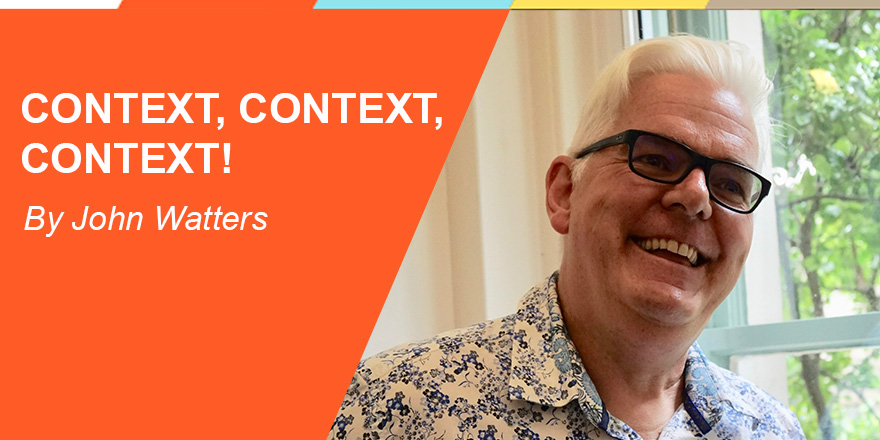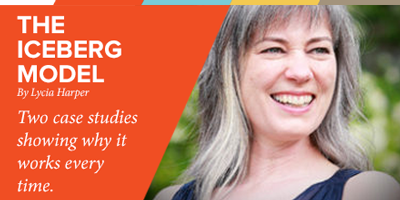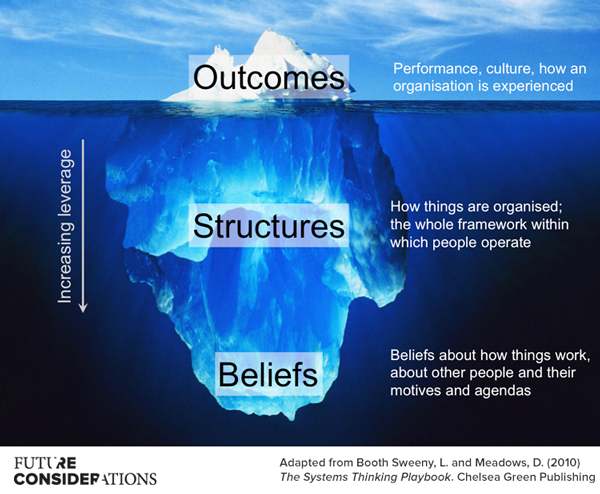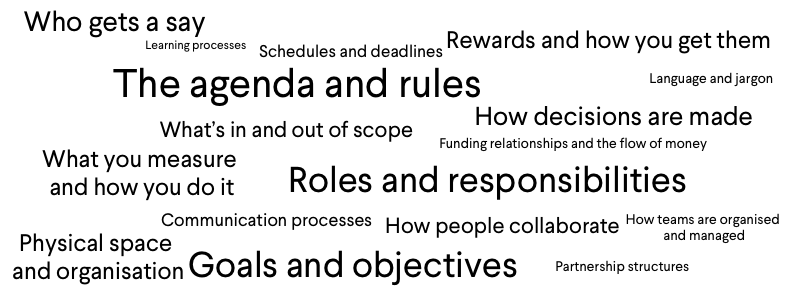

I had the experience again. I offered a simple iceberg model and my client seized on it, waved it around and started using phrases like “going deeper in the iceberg”. It happens every time I share it; people love it.

You might not love this model if you’re a purist about complexity science or a stickler for precision. You might balk at its simplicity and the things it omits. You might find it wonderful and marvel at how it helps people shift to a more systemic way of looking at things.
There are many versions of the iceberg model. The original for this one came from The Systems Thinking Playbook by Linda Booth Sweeney and Dennis Meadows (thanks and respect – it’s a brilliant book). I have adapted it as I’ve used it with people.
This model is a very simple representation of a complex system. It uses the metaphor of an iceberg to illustrate that our experiences are deeply influenced by dynamics we cannot easily see: the structures that form the framework within which we operate, and the beliefs we hold about how things work.
It’s simple and easy to understand and seems to be at a ‘Mummy Bear’, medium level of abstraction – not so specific that it’s scary and not so vague that it loses all meaning.
Its great strength seems to be that it puts the client in the driving seat in a conversation about the interventions to try in their organisation. A light goes on for people when they see the list of structures, the ‘levers’ they can pull. It often triggers new insight about what they’re experiencing and new ideas for how to intervene.
“Where do we have permission, agency and appetite to experiment?”
The conversation often starts with structures and flows into beliefs, and a richer picture emerges.

This example comes from a transformation project I ran for an arts organisation. One of the ‘hot’ presenting issues was the pickle they were in with their creative meetings. “People weren’t talking and the meetings weren’t functional. Our work is creative, about emotion and passion, but people were detached; I was flummoxed as to why people weren’t contributing,” said the meeting owner.
Some of the hidden dynamics were around the power structures underpinning the ideas process: whose ideas were taken seriously and the process by which ideas came to life. It pointed to some organisational beliefs about creativity and the hierarchies that existed but neither of these were safe topics for discussion at the time. We could however talk about their structures such as their processes of communication and collaboration.
A shift happened after a systems game when I used the iceberg model to help them make sense of their experiences and open up a conversation about the experiments they could run in their organisation. They wanted to put their energy into something that felt exciting and began talking about a new area in their building how they could set it up as a hot-desking space.
It proved to be a key intervention. People from other departments began to mix with ‘the ideas people’ and take part in the informal conversations leading up to the creative meetings. The conversations shifted and the old beliefs about who was qualified to develop ideas began to dissolve – without us having to address them directly. There were other dynamics and interventions but the hot-desking space was an important catalyst for change. It seemed to unlock enough for people to begin to experiment in other areas.
“You can’t underestimate the incredible difference moving offices made, and it already feels different, with a focus on conversation rather than email.”
“Creative team meetings have a new lease of life. They aren’t about putting ideas into practice any more; they’re about practising being creative together. We’re changing the format every time and asking who wants to get involved from the whole of the organisation.”
“There’s a new mindset; we understand things differently.”
There’s another aspect to this: using the iceberg model to remind ourselves about the influence the structures and beliefs can have on behaviours – and how creative people can be in delivering exactly what you ask for.

A very large, global organisation wanted to increase ‘employee engagement’ in community investment across their offices around the world. ‘Engagement’ was defined as ‘the number of employees participating’ across a of programmes and a high target was set.
The retail guys rolled up their sleeves, delivered some amazing projects, raised a record-breaking amount of money for charity and moved the dial on brand loyalty with some great local PR. Employee satisfaction moved up a notch with community participation cited as one of the top 3 reasons to work for their part of the organisation. They did a great job – but missed the participation target.
The finance guys took a different approach. Their manager heavily promoted payroll giving where employees could donate the ‘pennies’ from their salary – so each person would donate between 1-99p (or cents) each month. They raised relatively little money and people didn’t have the experience of participating in anything so it didn’t affect employee satisfaction or the brand. They did however completely blast the target, the only part of the organisation to do so.
It won’t go down as a great example of employee engagement, but was a lovely lesson in how influential measurement is.
[optin-monster-shortcode id=”kao0uahw4xzneklks44q”]
===
I (Lycia) help people think and act systemically based on the science of how complex systems work and evolve. Click here to get in touch.
Future Considerations Ltd
29 Adonis Street, Acropolis
Subdivision, Libis,
Quezon City,
Philippines 1110
Jon’s early career designing applications led to him becoming IT director for a market-leading multinational. His systemic perspective, allied with a background in psychology and subsequent leadership experience inside major organisations was followed by intensive learning in personal development, values systems and multiple intelligences. Brought together, these create a transformational perspective for understanding and developing organisations as living systems. Jon is a master trainer in Spiral Dynamics, a founder director of the UK chapter of Conscious Capitalism and a certified Spiritual Intelligence coach. He is the author of several books and articles and is developer of Relational Being, a visionary whole systems approach to evidence-based spirituality, complexity science, human emergence, societal change and conscious business. This breadth of experience and deep understanding informs his work as a consultant, coach, trainer and facilitator.